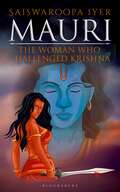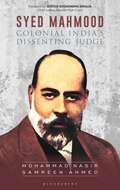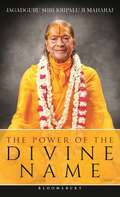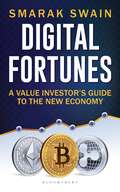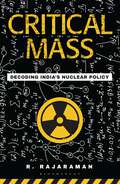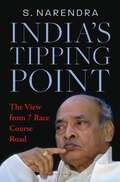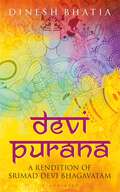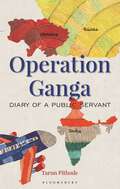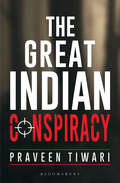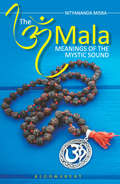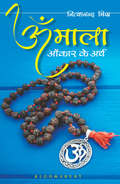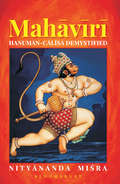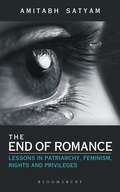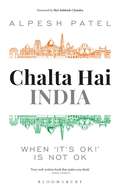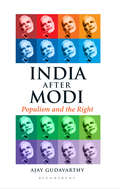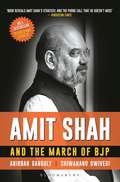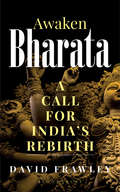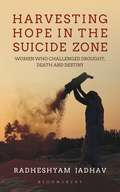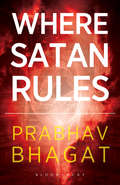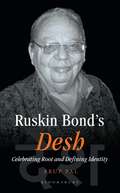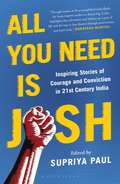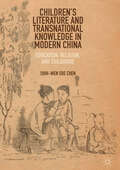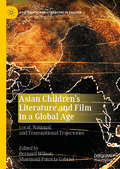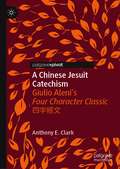- Table View
- List View
Mauri: The Woman Who Challenged Krishna
by Saiswaroopa IyerShe wants to kill the man whom others call God. However, love unwittingly becomes an obstacle in her sworn path. With her father's death shattering her world, Mauri is torn away from everything she had once loved. Anger has replaced every emotion within her, and she seeks only one thing-to kill her father's killer. Even if the man is none other than Krishna Vaasudeva, the man whom people worship as God. Someone is standing in the way though, reining in her bitterness when she is least prepared for it-the rakshasa prince Ghatotkacha! But by the time love sprouts within her, Mauri has gone too far in her thirst for vengeance and has endangered Kamarupa, the high seat of the Supreme Goddess. Does Ghatotkacha realise the true intentions of his lover? Can Mauri fight her own monsters and defend the temple? Can she save herself and Ghatotkacha before both their worlds are destroyed? Can Mauri fight her own monsters and defend the temple?Can Mauri save herself and Ghatotkacha before both their worlds are destroyed?
Syed Mahmood: Colonial India’s Dissenting Judge
by Mohammad Nasir Samreen AhmedAt a time when ordinary courage has become rare, one has to look up to the lives of those who stood for dissent in the colonial era. Back in the 19th century, Justice Syed Mahmood, son of the great social reformer Sir Syed Ahmad Khan, became the first judge to resist colonial power by espousing the cause of judicial independence. At the age of just 32, he not only remains the youngest, but also the first Indian Muslim and first north Indian to be appointed as a High Court judge in India. Endowed with a judicial acuity ahead of his times, a number of his dissents were later accepted by the courts, and continue to be the law.This book chronicles the triumphs and tragedies of Syed Mahmood's life, and his contribution in shaping the consciousness of post 1857 India. With an impressive array of research, perception and analysis, the book succeeds in exhuming a seminal figure from the dust of history, and showcases the past speaking to the present.
The Power of Divine Name
by Jagadguru Shri MaharajChanting God's name is a common spiritual practice. According to the scriptures, such is the glory of God's name, that uttering it even once has the power to take away all our sins and miseries. Many of us name our children, homes and businesses after God, even practice chanting, yet we do not see any noteworthy spiritual progress.The Power of the Divine Name explains the science of chanting and provides scriptural evidence that dissolves superstitions and misconceptions. It reveals and recommends the proper way to chant God's name. Drawing on his vast knowledge of the scriptures, Jagadguru Shri Kripalu Ji Maharaj interprets them for modern life. Told with simplicity and filled with anecdotes, the Jagadguru's words help us apply spiritual principles to our everyday life.
Digital Fortunes: A Value Investor's Guide to the New Economy
by Smarak SwainFor their pioneering work in the valuation of stock options, Robert Merton and Myron Scholes were awarded the Nobel Prize in Economics in 1997. The two laureates were also partners in a hedge fund which invested in stock options. It was a huge fund that had to be saved from bankruptcy in 1998 after the Russian financial crisis. Scholes went on to set up another hedge fund. This too went bankrupt in 2008. What is true for these Nobel laureates is true for most of us-the so-called pulse of the market is indecipherable. In a world transformed by digital technologies, the landscape of business and economy is subject to dramatic shifts. The disruption will only accelerate with the growth of AI, 5G technology, internet of things and much else. Digital Fortunes explores the impact of these technologies, delving into the key drivers of value: networks, which have helped create the platform economy, and crypto currencies, where truth and falsehood can be blurred. It also covers the all-important question of valuation. As a policymaker developing regulation, Smarak Swain is uniquely positioned to understand digital transformation. He draws on his distinctive experience and perspective to provide a clear and invaluable guide to navigate a rewarding but risky area.
Critical Mass: Decoding India’s Nuclear Policy
by R. RajaramanIn a critical discussion of India's nuclear doctrine and its components of no first use and credible minimum deterrence, R. Rajaraman argues that, contrary to fears expressed in the media and the literature, the effectiveness of the deterrent is not reduced if China has thermonuclear bombs while India does not. Or if, as sometimes reported in the media, Pakistan has a few more warheads than India does. What matters is India having enough surviving nuclear weapons to launch a Second Strike on the adversary that inflicted 'Unacceptable Damage'. In order to lift the veil of irrational fear and unnecessary opacity surrounding this area, the actual damage caused by a nuclear explosion and its radiation fallout is described in a transparent manner.On nuclear energy, Rajaraman offers a detailed assessment of the Indian government's ambitious reactor programme, including a discussion of the India– US Nuclear Deal, the Nuclear Liability Law and their impact. On the global stage, he also covers measures to secure nuclear materials to prevent terrorism. The efforts include the FMCT negotiations, the Obama Summit and the NTI Index.Critical Mass thus offers a unique perspective on nuclear developments in India, covering both civil and military affairs. Written in a lucid manner such that it is accessible to a layperson, the book is illustrated with photographs and with anecdotes of the author's own experiences in the field. It succeeds in its admirable aim of decoding India's nuclear policy in a manner that enables the reader to form their own judgement on strategic matters.
India's Tipping Point: The View From 7 Race Course Road
by S. NarendraIn September of 2022, India's GDP crossed that of Britain to make it the world's fifth largest economy. For a country that had been struggling with slow growth for decades, it was a significant moment. The tipping point-that moment when a process of change is initiated which will transform how we think, behave or live-came in the summer of 1991 under the leadership of someone considered the person least likely to launch such a change. The government of P.V. Narasimha Rao, who had just turned 70, announced a series of measures that have today placed India among the top economies. This was not all. The five years of his prime-ministership, from 1991 to 1996, were marked by several other changes whose impact continues to be felt. Alongside devastating events like the Babri Masjid demolition and tackling bitter politics in a divided Congress party.S. Narendra was a close associate through this period and sheds light on many key events and the internecine rivalries and politics that Rao had to counter to be able to function. He was a cog in the wheel of bigger things but perfectly placed to see what happened in the grey area between policy-making, administration and politics, and to explain, at least in part, the actions of the man at the centre of it all. This is a first-hand, indispensable account of history in the making.
Devi Purana: A Rendition of Srimad Devi Bhagavatam
by Dinesh BhatiaSrimad Devi Bhagavatam, also known as Devi Purana, is one of the many works of Maharishi Veda Vyasa. Consisting of 18,000 verses, it is divided into 12 chapters and numerous sections. Though classified as an upapurana (sub-Purana), it is the only Purana that Veda Vyasa terms 'Mahapurana', or the great Purana, at the end of each chapter. Vyasa's narration reiterates that the Supreme Goddess or the Divine Mother, as described in all scriptures, is the one beyond and above the Trinity of Gods and all Devas. The stories in the book not only establish this but also describe various manifestations of the Devi. All the Puranas are essentially collections of stories, through a narrator called Suta, who heard these from his guru, Vyasa. These, in their original form, are woven like a web and are not easy to comprehend since there is no defined order, be it chronological or otherwise. Dinesh Bhatia segregates and simplifies the stories as well as their underlying philosophies in order to present them in a simple and comprehensible way. He also reorganises the flow of stories as a direct narration by Vyasa to King Janamejaya, the grandson of Abhimanyu, while retaining the essence of the original work.
Operation Ganga: The Diary of a Public Servant
by Tarun PithodeAs war clouds began to loom over Ukraine, thousands of Indian students living there found themselves in a precarious situation. Some students left Ukraine in time, but many remained in the hope that there would be no war, or if there was, it would not affect their studies. However, hope turned into disappointment when all foreign students were advised to leave. Operation Ganga was a campaign conducted by the Government of India to evacuate Indian citizens, mostly students, during the Russia–Ukraine War. The Government of India appealed to all the countries of Europe, the Indian diaspora, Indian embassies, the corporate world and social and religious organisations to provide all possible support in moving Indian students back home from the troubled area. Farish was studying medicine in Sumi. He and his friends were helped by people at the Indian embassy to move through the Ukraine border into Poland. From Poland, transit and food was provided free of cost by the Indian government. The repatriation of Farish is but one success story. Tarun Pithode chronicles of the sufferings of thestudents and their harrowing journeys, and the role of the Government of India and numerous Indians in rescuing them.
The Great Indian Conspiracy
by Dr. Praveen TiwariSaffron terrorism. Is it a fact? Or, is this a myth? After all, do we know enough? The shocking blasts of Malegaon and Samjhauta were projected as 'saffron terrorism'. A new theory, terrorist attacks were tainted as such till, a few years later, Kasab's confession offered solid proof of Pakistan's role in the 26/11 attacks. Though the police had concluded a Pakistani hand for the earlier blasts, it was saffron terrorism which prevented the perpetrators of these attacks from being brought to justice. As a theory, saffron terrorism is not just hurting Hindus sentiments but is also an obstacle to fight real terrorism sponsored by Pakistan and Islamic states. The term was coined by the erstwhile UPA government to garner minority votes and manipulate the vote bank. After all, why were the Malegaon-accused SIMI activists let off? Why did certain politicians declare not to oppose their bail? What was truly behind Aseemanand's confession? The reliability of these confessions was questionable given the police brutality that the National Investigative Agency exposed. Journalist Praveen Tiwari explores saffron terrorism and reveals through exclusive interviews of senior National Investigative Agency officials, undercover agents and politicians how vote bank politics can compromise ethics and national security. Should the real masterminds behind the blasts be allowed to go scot-free? Should the manipulators of the Samjhauta Express bombings not be held accountable? Should we not investigate those who had exonerated Pakistan of its guilt? An extensive research on communal politics, the book offers indisputable evidence of the 'saffron terrorism' theory as the Great Indian Conspiracy.
The Om Mala: Meanings of the Mystic Sound
by Nityanand MisraThe OM Mala is a book (and a mala or a rosary) about just one word-OM. OM is one of the shortest Sanskrit words, and yet is perhaps the most powerful one, besides being a globally recognized mystic mantra.The OM Mala gives 84 names of OM from Sanskrit texts and explains their meanings in 109 sections or beads: 108 chanting beads and one 'sumeru' bead. Each bead offers the meaning(s), explanation, traditions, etymology, and quotations for one or more names of OM. The book covers rare names of OM like 'shrutipada' and 'rasa' as well as common names like 'om', 'udgitha', and 'pranava'. Popular meanings (like Brahma-Vishnu-Shiva) and rare meanings (like inhalation, holding the breath, and exhalation) are included.The book contains teachings and narratives related to OM from Veda-s, Upanishad-s, Smriti-s, Purana-s, Ramayana, Mahabharata, Gita, Yoga, Tantra, Vaishnavism, Shaivism, and Shaktism. Pearls on OM from poems, plays, and works on music and Ayurveda are presented. The use of OM in Yogic breathing and meditation is explained and the explanations/relevance of OM in Jainism, Buddhism, and Sikhism is briefly touched upon. The OM Mala is a mini-encyclopaedia on OM and associated concepts in Indian religions and culture.
Om Mala: Omkar Ke Arth
by Nityanand MisraThe OM Mala is a book (and a mala or a rosary) about just one word-OM. OM is one of the shortest Sanskrit words, and yet is perhaps the most powerful one, besides being a globally recognized mystic mantra.The OM Mala gives 84 names of OM from Sanskrit texts and explains their meanings in 109 sections or beads: 108 chanting beads and one 'sumeru' bead. Each bead offers the meaning(s), explanation, traditions, etymology, and quotations for one or more names of OM. The book covers rare names of OM like 'shrutipada' and 'rasa' as well as common names like 'om', 'udgitha', and 'pranava'. Popular meanings (like Brahma-Vishnu-Shiva) and rare meanings (like inhalation, holding the breath, and exhalation) are included.The book contains teachings and narratives related to OM from Veda-s, Upanishad-s, Smriti-s, Purana-s, Ramayana, Mahabharata, Gita, Yoga, Tantra, Vaishnavism, Shaivism, and Shaktism. Pearls on OM from poems, plays, and works on music and Ayurveda are presented. The use of OM in Yogic breathing and meditation is explained and the explanations/relevance of OM in Jainism, Buddhism, and Sikhism is briefly touched upon. The OM Mala is a mini-encyclopaedia on OM and associated concepts in Indian religions and culture.
Mahaviri: Hanuman Chalisa Demystified
by Nityanand MisraThe Hanuman Chalisa authored by Goswami Tulsidas is one of the most popular Hindu devotional hymns. The 'Mahaviri' Hindi commentary (1984) by Swami Rambhadracharya has been acclaimed as the best treatise on the Hanuman Chalisa. This book presents an annotated and expanded English translation of the 'Mahaviri' commentary by Nityanand Misra.Each of the 43 verses of the 'Hanuman Chalisa' is explained in three stages. The first phase being a word-for-word translation to help the reader understand the literal meaning of each word in a verse. The second is a simple English translation of each verse. This third and final phase is an informed commentary on the true meaning of the verse, explaining the deep essence of the text with citations from authoritative Hindu scriptures (the Vedas, Upanishads, Puranas, Ramayana, Mahabharata, Gita, etc.) and other works of Goswami Tulsidas. All such citations are also translated into English.Following the commentary, Misra also provides five useful appendices for advanced readers. These include more than 120 endnotes (annotations), a detailed note on the prosody and rhythm of all the verses for chanters, the musical notation of the traditional melody of the Hanuman Chalisa for devotional singers and instrumentalists, and two alphabetical indexes for all words and verses used in the hymn.The book is a must-have for reciters and singers of the Hanuman Chalisa who want to understand the deep essence of Tulsidas's timeless hymn to Hanuman. It targets laypersons as well as scholarly readers. The design of the book, including font sizes and line spacing, is suitable for the elderly as well. The book has reached thousands of readers across the globe and has been praised as “the most comprehensive guide to the Hanuman Chalisa available in English”. It has been loved by readers for not only its scholarship and research, but also for its beautiful production, aesthetic typeface, attractive layout, and excellent footnotes and appendices.
The End of Romance: Lessons in Patriarchy, Feminism, Rights and Privileges
by Amitabh SatyamTwo genders made by nature coexisted comfortably forever, till about a few hundred years ago when men and women started identifying themselves differently. These identities started hardening over time and today they appear to be a different species in many situations… Sometimes laugh-out-loud, at times, deeply poignant, and at other times, provoking and questioning, The End of Romance is a fantastic, one-of-its-kind take on patriarchy and feminism, rights and privileges, abuse and consent, and cultures and laws related to men-women conflicts.Peppered with anecdotes, real-life incidents and everyday stories, the book discusses the natural, cultural and religious influences on the man-woman relationship and how this has evolved over time. The author asks questions few would ever utter: Is our society increasingly becoming anti-men? If so, will this lead to any good? Are gender dynamics always tilted only to benefit one gender? Can we ever achieve equality? These are debated with an analysis of the privileges of women and the abuse of men, a discussion on the prevailing myths, followed by recommendations on how the relationship can be brought back to equal. Unabashed, hilarious, and at times caustic, The End of Romance signals what most of us miss: Oppressive societies do not survive, whoever it may benefit at the moment.
Chalta Hai India: When ‘It’s Ok!’ is Not Ok
by Alpesh PatelIndia once commanded a massive 30 per cent share of the global GDP and led the world in most fields, but today the country sadly is a developing nation. People often attribute India's sluggish progress to the malaise called the Chalta Hai ('It's okay', 'Let it be') attitude, but not everyone agrees with that presupposition. Debates on the subject are often inconclusive and discomfiting questions remain unanswered. Are we really a Chalta Hai nation? Is Chalta Hai ingrained in our DNA or is it just a bad habit which can be easily exterminated? Will this attitude stop India from becoming a global power?Alpesh Patel delves into this quirky Indian approach and answers these questions by examining the country's pace of progress in fields such as education, infrastructure, films and sports since Independence. The book revisits our cultural, ideological and political history over three millennia to trace the roots of the Chalta Hai attitude of Indians. Interesting facts and unsettling inferences force the reader to introspect and awaken him to the need for an urgent action. Finally, the book charts out methods and suggestions on how to get rid of the Chalta Hai attitude and take India closer to the dream of becoming a developed nation.
India After Modi: Populism And The Right
by Ajay GudavarthyHave you realized that the divide between 'Us' and 'Them' has grown steadily in Indian politics? Do you sometimes wonder whether it will be repaired at all in the near future? Do you ever pause to reflect why emotions spill on the streets and why democratic institutions in India have become dysfunctional? Have you thought about why we get hurt easily and how this gets reflected in everyday politics?India after Modi attempts to address these questions through an analysis of events like Award Wapsi, demonetization, the crisis in JNU and higher education, and electoral outcomes, including in the states of Bihar, Delhi and Uttar Pradesh. Through this collection of essays, Ajay Gudavarthy focuses exclusively on Indian democracy after Narendra Modi took over as the prime minister in 2014. He looks at the politics that India has been witnessing since then and addresses emerging issues in Indian democracy, including that of women's participation, new urban spaces, and the role of youth.
Amit Shah and the March of BJP
by Anirban Ganguly Shiwanand DwivediThe story of Amit Shah's political life, struggles, rise and triumph is little known. For a leader who is often referred to as the Chanakya of Indian politics, who has dominated India's fast-paced and complex political stage since 2014, has altered its electoral map by leading the Bharatiya Janata Party (BJP) to successive historic victories post the May 2014 general elections, there is very little that is recorded or narrated. So, it's no surprise that the curiosity he evokes is ever on the rise.Most of what is written about Amit Shah is based on conjectures, hearsay, assumptions and biases. The real Amit Shah-the once booth-worker and now national president of the largest political party in the world, the master strategist who has pushed the BJP to an organisational pinnacle and yet talks of scaling peaks, a man who is unhesitant in his stand on nationalism and on anything which concerns India's national interest-has remained in the shadows, self-effaced, away from the limelight. The story of how he expanded the BJP into a pan-India party and the convergence of organisational science and ideology that has made the BJP a unique and formidable political entity is a story that needs to be told. The book narrates the personal and political journey of Amit Shah, captures the ideological world that shaped him and gives an account of the party that he is leading and shaping today. It is for the first time that his story is being told-an authentic, no-holds-barred portrayal of one of the most influential leaders of our times. To the political worker, the observer and to anyone even remotely interested in Indian politics, irrespective of their profession or political leaning, especially since the unfolding of Indian politics in the summer of 2014, this is a captivating exploration of the political life and journey of one of its central characters.
Awaken Bharata: A Call for India’s Rebirth
by David FrawleyToday there is a new battle going on over the 'idea of India', with some groups questioning if there ever was any real nation called 'India' prior to the British rule. Challenging this notion are those who claim that India has a profound national and cultural heritage since ancient times and was one of the main centres of civilization in the world, with its own characteristic ideals and practices born of dharma and yoga. The Constitution speaks of India that is Bharata, proclaiming this ancient name for the country. If we look at India as Bharata, the idea of the country and its unique identity and history become clear. Awaken Bharata is a plea for that eternal India to awaken and reclaim its esteemed place as the guru of nations, expressing once more its vast civilizational ethos. The book encourages a new vision of the country, linking its magnificent past with a more brilliant future. It emphasizes the role of a new 'intellectual kshatriya'-intellectual warriors of dharma-to challenge the inimical forces seeking to deny or displace India's great civilization.
Harvesting Hope in the Suicide Zone: Women Who Challenged Drought, Death and Destiny
by Radheshyam JadhavAs the flames danced all around her small hut, Vidya More had to make a hard choice. She could follow her husband into the fire along with her children. Or she could save herself and her little children from a terrible death. Acclaimed journalist Radheshyam Jadhav brings to readers true inspiring stories of women farmers and farm widows, like Vidya and many more, from the 'farmer suicide zone' of Maharashtra. These women have battled the tremendous odds-of poverty, misogyny and inequity-stacked against them to herald a silent revolution to overcome agrarian crisis. These feisty women wake up every morning and battle for survival. Suicide, unlike their husbands, is a luxury they can't afford. Extensively researched along with personal interviews, the book captures the women's stories and constructive struggle and how they discovered in themselves endless reserves of strength. While the men are driven to despair and death by debts, the women have fought their battles and found answers to the crisis. These simple, and often uneducated, women have developed their own methodology and science to manage and tackle drought and are experimenting with every possible option to give themselves and their families a life of dignity. They have taken up tough challenges and are sowing determination and hard work to achieve their dreams. The book captures their belief that dreams often come true. And hope is what keeps life going.
Where Satan Rules
by Prabhav BhagatBefore my time too, there have been cases of a ghost writing a journal to tell the truth about his life ...Mike Carterson is hounded by death. When the Japanese bomb Pearl Harbour, his parents are killed-along with thousands of other Americans. Mike and his friend Alex Gutherburg land up in an orphanage, from which they run away to try to cross the mighty Pacific in a small boat.When death looms again, they are saved by the SS Atlantic of the US Navy. Their fun life on board, however, is suddenly interrupted when their ship is given a strange assignment: to investigate the mysterious disappearances in the Bermuda Triangle.Mike and Alex are tormented by strange premonitions of the doom that awaits them in the Bermuda Triangle but the captain of the ship pays no heed to their warnings. And as the SS Atlantic enters the 'Devil's Triangle', they begin to encounter forces never imagined which spell doom not only for them but for all of humanity ... What are the chilling secrets that the Bermuda Triangle hides? Will Mike and Alex survive in the realm where Satan rules?
Ruskin Bond's Desh: Celebrating Root and Defining Identity
by Arup PalThis book explores the dilemma of Bond's 'two selves' and his existential search for an identity. This exploration, analysed across six chapters, is informed by a variety of postcolonial, historical, informational and critical texts on Bond and Anglo-Indians. Arup Pal focuses on four key literary works of Bond-The Room on the Roof, A Flight of Pigeons, Scenes from a Writer's Life and A Handful of Nuts-from the perspective of the author's developing sense of personal, national and cultural identity. He traces the journey that the author and his protagonists embark on in order to seek and ultimately define their sense of being.
All You Need is Josh: Inspiring Stories of Courage and Conviction in 21st Century India
by Supriya PaulIn a world filled with cynicism, few stand tall, carving their own path to success with courage, determination and grit. All You Need Is Josh brings to you stories of such unique individuals across India – of the aspiring astrophysicist who wanted to walk on the moon; the first person with a disability to top the civil services examinations; the domestic help who is now a published author; the army officer who amputated his own leg; the transgender woman who was expelled from her house; the Dalit child bride who now runs a business worth Rs1,000 crores, and many more.Filled with anecdotes and life-changing missives, these stories will remind you that it does not matter the circumstancesinto which one is born – what matters most is having the josh to overcome all odds and chase your dreams.
Ruskin Bond's Desh: Celebrating Root and Defining Identity
by Arup PalThis book explores the dilemma of Bond's 'two selves' and his existential search for an identity. This exploration, analysed across six chapters, is informed by a variety of postcolonial, historical, informational and critical texts on Bond and Anglo-Indians. Arup Pal focuses on four key literary works of Bond-The Room on the Roof, A Flight of Pigeons, Scenes from a Writer's Life and A Handful of Nuts-from the perspective of the author's developing sense of personal, national and cultural identity. He traces the journey that the author and his protagonists embark on in order to seek and ultimately define their sense of being.
Children’s Literature and Transnational Knowledge in Modern China: Education, Religion, and Childhood
by Shih-Wen Sue ChenThis book examines the development of Chinese children’s literature from the late Qing to early Republican era. It highlights the transnational flows of knowledge, texts, and cultures during a time when children’s literature in China and the West was developing rapidly. Drawing from a rich archive of periodicals, novels, tracts, primers, and textbooks, the author analyzes how Chinese children’s literature published by Protestant missionaries and Chinese educators in the late nineteenth and early twentieth centuries presented varying notions of childhood. In this period of dramatic transition from the dynastic Qing empire to the new Republican China, young readers were offered different models of childhood, some of which challenged dominant Confucian ideas of what it meant to be a child. This volume sheds new light on a little-explored aspect of Chinese literary history. Through its contributions to the fields of children’s literature, book history, missionary history, and translation studies, it enhances our understanding of the negotiations between Chinese and Western cultures that shaped the publication and reception of Chinese texts for children.
Asian Children’s Literature and Film in a Global Age: Local, National, and Transnational Trajectories (Asia-Pacific and Literature in English)
by Bernard Wilson Sharmani Patricia GabrielThis volume provides a key analysis of Asian children’s literature and film and creates a dialogue between East and West and between the cultures from which they emerge, within the complex symbiosis of their local, national and transnational frameworks. In terms of location and content the book embraces a broad scope, including contributions related to the Asian-American diaspora, China, India, Indonesia, Iran, Japan, Malaysia, the Philippines, South Korea, Sri Lanka, and Taiwan. Individually and collectively, these essays broach crucial questions: What elements of Asian literature and film make them distinctive, both within their own specific culture and within the broader Asian area? What aspects link them to these genres in other parts of the world? How have they represented and shaped the societies and cultures they inhabit? What moral codes do they address, underpin, or contest? The volume provides further voice to the increasingly diverse and fascinating output of the region and emphasises the importance of Asian art forms as depictions of specific cultures but also of their connection to broader themes in children’s texts, and scholarship within this field.
A Chinese Jesuit Catechism: Giulio Aleni’s Four Character Classic 四字經文 (Christianity in Modern China)
by Anthony E. ClarkThis book is the first scholarly study of the famous Jesuit Chinese children’s primer, the Four Character Classic, written by Giulio Aleni (1582–1649) while living in Fujian, China. This book also includes masterful translations of both Wang Yinglin’s (1551–1602) hallowed Confucian Three Character Classic and Aleni’s Chinese catechism that was published during the Qing (1644–1911). Clark’s careful reading of the Four Character Classic provides new insights into an area of the Jesuit mission in early modern China that has so far been given little attention, the education of children. This book underscores how Aleni’s published work functions as a good example of the Jesuit use of normative Chinese print culture to serve the catechetical exigencies of the Catholic mission in East Asia, particularly his meticulous imitation of Confucian children’s primers to promote decidedly Christian content.
